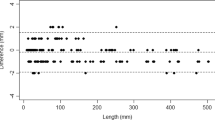Abstract
Forensic anthropologists are often consulted to estimate aspects of the biological profile, such as age, ancestry, sex and stature from unidentified skeletal remains. Estimating ancestry is especially challenging in developed countries that have large numbers of immigrants from underdeveloped countries. Many developed countries have also experienced secular changes in the well-established populations, most notably an increase in stature over the last 150 years, which often brings changes in cranial morphology. In order to keep forensic anthropological standards up to date with population changes in the United States, the Forensic Data Bank (FDB) of demographic and skeletal information was established. Fordisc 3 is the latest generation of statistical software to aid in constructing a biological profile using FDB data and multivariate statistical methods. Fordisc 3 is used by forensic anthropologists around the world and is regularly being improved and expanded.
Zusammenfassung
Eine häufige Aufgabe für forensische Anthropologen ist die Erstellung eines biologischen Profils von nichtidentifizierten skeletierten menschlichen Überresten. Hierbei werden u. a. Aussagen zu Alter, Herkunft, Geschlecht und Körperhöhe erwartet. Die Bestimmung der Herkunft stellt eine große Herausforderung dar, insbesondere in den Industrieländern mit einer hohen Zahl von Migranten und Zuwanderern. Viele Länder haben zudem bei den alteingesessenen Populationen säkuläre Veränderungen erfahren, die gravierendsten bei der Zunahme der Körperhöhe innerhalb der letzten 150 Jahre, häufig außerdem verbunden mit Veränderungen der Schädelmorphologie. Mit dem Ziel, die aktuell gültigen forensisch-anthropologischen Standards auf der Höhe der andauernden Populationsentwicklungen in den USA zu halten, wurde die Forensic Data Bank (FDB) mit demografischen und skeletalen Daten aufgebaut. Fordisc 3 repräsentiert die derzeit aktuellste Version einer statistischen Software, die basierend auf multivariaten statistischen Methoden dazu beiträgt, ein biologisches Profil unter Verwendung der FDB-Daten zu erstellen. Fordisc wird weltweit von forensischen Anthropologen eingesetzt. Die Datenbasis und der Leistungsumfang der Software werden regelmäßig erweitert und fortentwickelt.
Similar content being viewed by others
References
Ayers HG, Jantz RL, Moore-Jansen PH (1990) Giles and Elliot race discriminant functions revisited: a test using recent forensic cases. In: Gill GW, Rhine S (eds) Skeletal attribution of race. Maxwell Museum of Anthropology, Albuquerque, pp 65–71
Boldsen JL, Milner GR, Konigsberg LW, Wood JW (2002) Transition analysis: a new method for estimating age from skeletons. In: Hoppa RD, Vaupel JW (eds) Paleodemography: age distributions from skeletal samples. Cambridge University Press, Cambridge, pp 73–106
Dirkmaat DC, Cabo LL, Ousley SD, Symes SA (2008) New perspectives in forensic anthropology. Am J Phys Anthropol 51:33–52
Geserick G, Schmeling A (2011) Qualitätssicherung der forensischen Altersdiagnostik bei lebenden Personen. Rechtsmedizin 21:22–25
Giles E, Elliot O (1962) Race identification from cranial measurements. J Forensic Sci 7:147–157
Hädrich C, Bock S, Dreßler J (2011) Leichenschau nach 1000 Jahren. Rechtsmedizin 21:465–468
Hefner JT (2009) Cranial nonmetric variation and estimating ancestry. J Forensic Sci 54:985–995
Hefner JT, Ousley SD (2013) Statistical classification methods for estimating ancestry using morphoscopic traits. J Forensic Sci (under review)
Howells WW (1973) Cranial variation in man: a study by multivariate analysis of patterns of difference among recent human populations. Papers of the Peabody Museum, vol 67. Peabody Museum of Archeology and Ethnology, Harvard University, Cambridge
Jantz RL, Moore-Jansen PH (1987) A data base for forensic anthropology. Washington, D.C. 20531: final report to the National Institute of Justice, Grant No. 85-1 J-CX-0021. https://www.ncjrs.gov/pdffiles1/nij/111608.pdf
Jantz RL, Ousley SD (1993) Fordisc 1.0: computerized forensic discriminant functions. The University of Tennessee, Knoxville
Jantz RL, Ousley SD (2013) Introduction to Fordisc 3. In: Tersigni-Tarrant MT, Shirley N (eds) Forensic anthropology: an introduction. CRC, Boca Raton, pp 253–269
Jantz RL, Ousley SD (2005) Fordisc 3: computerized forensic discriminant functions, version 3.1. The University of Tennessee, Knoxville
Lehn C, Graw M (2012) Wie viel Regionalität steckt in Körpergewebe? Isotopenmethoden zur geografischen Herkunftsbestimmung von unbekannten Toten. Rechtsmedizin 22:99–105
Milner GR, Boldsen JL (2012) Transition analysis: a validation study with known-age modern American skeletons. Am J Phys Anthropol 148:98–110
Moore-Jansen PH, Jantz RL (1986) A computerized skeletal data bank for forensic anthropology. University of Tennessee, Knoxville
Ousley SD (2012) Estimating stature. In: Dirkmaat DC (ed) A companion to forensic anthropology. Wiley-Blackwell, London, pp 330–334
Ousley SD, Billeck WT, Hollinger RE (2005) Federal repatriation legislation and the role of physical anthropology in repatriation. Yearb Phys Anthropol 48:2–32
Ousley SD, Hollinger RE (2012) The pervasiveness of Daubert. In: Dirkmaat DC (ed) A companion to forensic anthropology. Wiley-Blackwell, London, pp 654–665
Ousley SD, Jantz RL (1996) Fordisc 2.0: personal computer forensic discriminant functions. University of Tennessee, Knoxville
Ousley SD, Jantz RL (1997) The forensic data bank: documenting skeletal trends in the United States. In: Reichs K (ed) Forensic osteology, 2nd edn. Thomas, Springfield, pp 297–315
Ousley SD, Jantz RL (2012) Fordisc 3 and statistical methods for estimating sex and ancestry. In: Dirkmaat DC (ed) A companion to forensic anthropology. Wiley-Blackwell, London, pp 311–329
Ousley S, Jantz R, Freid D (2009) Understanding race and human variation: why forensic anthropologists are good at identifying race. Am J Phys Anthropol 139:68–76
Ramsthaler F, Kreutz K, Verhoff MA (2007) Accuracy of metric sex analysis of skeletal remains using Fordisc based on a recent skull collection. Int J Legal Med 121:477–482
Stuller F, Novomesky F, Krajcovic J, Straka L (2011) Skelettreste aus dem Zeitraum des Zweiten Weltkriegs. Forensisch-anthropologische Expertisen. Rechtsmedizin 21:136–140
Zinka B, Kandlbinder R, Haas G et al (2011) Radionuklidanalyse von 228Th und 228Ra. Neue Methode zur Liegezeitbestimmung. Rechtsmedizin 21:124–130
Conflict of interest
The corresponding author states the following: The authors of the manuscript are the authors of the Fordisc software mentioned.
Author information
Authors and Affiliations
Corresponding author
Rights and permissions
About this article
Cite this article
Ousley, S., Jantz, R. Fordisc 3. Rechtsmedizin 23, 97–99 (2013). https://doi.org/10.1007/s00194-013-0874-9
Published:
Issue Date:
DOI: https://doi.org/10.1007/s00194-013-0874-9




